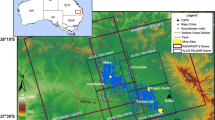Abstract
Employing the well-known D-InSAR technique, we investigated landslide monitoring in the Three Gorges region using TerraSAR-X data. The experiment demonstrates that using both the amplitude and differential phase allows us to identify the precise location, deformation and time range of occurrence of certain landslides. To overcome the atmospheric effect on D-InSAR results, a time-series analysis was also carried out. The observed nonlinear relationship between the deformation and water level suggests that reservoir water level fluctuation is one of the major causes of landslides, which is significant in terms of issuing landslide warnings. In addition, the comparison of TerraSAR-X and C-band ASAR data results indicates that TerraSAR-X data provide far more reasonable deformation measurements because of their high temporal and spatial resolutions.
Similar content being viewed by others
References
Ding J, Yang Z, Shang Y, et al. New prediction and warning method of landslide hazard triggered by heavy rainfall. Sci China Ser D-Earth Sci, 2006, 36: 579–586
Li L, the prevention and treatment of major geological disasters in Three Gorges Area. Land Resour, 2002, (4): 4–7
Peng X, Zhang Y, Yan D, et al. Deformation monitoring of several classic landslides after the impoundment of the Three Gorges Reservoir. In: Chinese Bureau of Geological Survey, ed. Geological Hazard Investigation and Monitoring Methods, Sept. 16–18, Beijing: China Land Press, 2004. 255–261
The Centre of Geology Hazards Prevention of Three Gorges Reservoir. Qianjiangping landslide in Zigui country, Hubei Province. Chin J Geol Hazard Contr, 2003, 14: 144
Liao M, Lin H. Synthetic Aperture Radar Interferometry-Principle and Signal Processing. Beijing: Surveying and Mapping Press, 2003. 167
Massonnet D, Rossi M, Carmona C. The displacement field of the Landers earthquake mapped by interferometry. Nature, 1993, 138–142
Zebker H A, Rosen P A, Goldstein R M, et al. On the derivation of coseismic displacement fields using differential radar interferometry: Landers earthquake. Inter Geosci Remote Sensing Symp, 1994, 1: 286–288
Shan X J, Ma J, Wang C L, et al. Co-seismic ground deformation and source parameters of Mani earthquake inferred from spaceborne D-InSAR observation data. Sci China Ser D-Earth Sci, 2002, 32: 837–844
Fruneau B, Achache J, Delacourt C. Observation and modeling of the Saint-Etienne-de-tinee landslide using SAR Interferometry. Tectonophysics, 1996, 265: 181–190
Ferretti A, Prati C, Rocca F. Nonlinear subsidence rate estimation using permanent scatterers in differential SAR interferometry. IEEE Trans Geosci Remote Sensing, 2000, 38: 2202–2212
Ferretti A, Prati C, Rocca F. Permanent scatterers in SAR interferometry. IEEE Trans Geosci Remote Sensing, 2001, 39: 8–20
Best M. Kampers, Radar Interferometry Scatterer Technique. Heidberg: Springer, 2006. 43–66
Ferretti A, Savio G, Barzaghi R, et al. Submillimeter accuracy of InSAR time series: Experimental validation. IEEE Trans Geosci Remote Sensing, 2007, 45: 1142–1153
Wang Y, Liao M S, Li D R, et al. Subsidence velocity retrieval from long-term coherent targets in radar interferometric stacks. Chin J Geophys, 2007, 50: 598–604
Hooper A J. Persistent scatterer radar interferometry for crustal deformation. Dissertation for the Doctoral Degree. Stanford: Stanford University, 2006
Hooper A. A multi-temporal InSAR method incorporating both persistent scatterer and small baseline approaches. Geophys Res Lett, 2008, 35: L16302.1–L16302.5
Colesanti C, Ferretti A, Prati C, et al. Monitoring landslides and tectonic motions with the Permanent Scatterers Technique. Eng Geol, 2003, 68: 3–14
Hilley G E, Burgmann R, Ferretti A, et al. Dynamics of slow-moving landslides from permanent scatterer analysis. Science, 2004, 304: 1952–1955
You X, Li S, Yang S, et al. Preliminary studies on InSAR application in Three Gorges Area. Crust Deform Earthq, 2001, 21: 58–66
Gao L, Zen Q. Terrain deformation monitoring in Three Gorges area using permanent scatterers SAR interferometry. In: Proceedings ScanGIS’2007, 2007
Wang T, Perissin D, Liao M, et al. Deformation monitoring by long-term D-InSAR analysis in Three Gorges area, China. In: 2008 IEEE International Geoscience and Remote Sensing Symposium-Proceedings, July 6–11, 2008. Boston: Institute of Electrical and Electronics Engineers Inc, 2008
Wang T, Liao M, Perissin D. InSAR coherence-decomposition analysis. Geosci Remote Sensing Lett IEEE, 2010, 7: 156–160
Wang T, Perissin D, Rocca F, et al. Three Gorges Dam stability monitoring with time series InSAR analysis. Sci China Ser D-Earth Sci, 2011, 54: 720–732
Liao M, Tian X, Zhao Q. TerraSAR-X/TanDEM-X radar remote sensing plan and application. J Geomatics, 2007, 32: 44–46
Wegmuller U, Walter D, Spreckels V, et al. Nonuniform ground motion monitoring with TerraSAR-X persistent scatterer interferometry. IEEE Trans Geosci Remote Sensing, 2010, 48: 895–904
Baran I, Stewart M, Claessens S. A new functional model for determining minimum and maximum detectable deformation gradient resolved by satellite radar interferometry. IEEE Trans Geosci Remote Sensing, 2005, 43: 675–682
Zebker H A, Rosen P A, Hensley S. Atmospheric effects in interferometric synthetic aperture radar surface deformation and topographic maps. J Geophys Res, 1997, 102: 7547–7563
Prati C, Ferretti A, Perissin D. Recent advances on surface ground deformation measurement by means of repeated space-borne SAR observation. J Geodyn, 2010, 49: 161–170
Chen T. Study on Stability Evaluation of the Large-Scale Bank Landslides Under the Running of the Three Gorges Reservoir (in Chinese). Chongqing: Chongqing Jiaotong University Press, 2009. 81
Author information
Authors and Affiliations
Corresponding author
Rights and permissions
About this article
Cite this article
Liao, M., Tang, J., Wang, T. et al. Landslide monitoring with high-resolution SAR data in the Three Gorges region. Sci. China Earth Sci. 55, 590–601 (2012). https://doi.org/10.1007/s11430-011-4259-1
Received:
Accepted:
Published:
Issue Date:
DOI: https://doi.org/10.1007/s11430-011-4259-1




